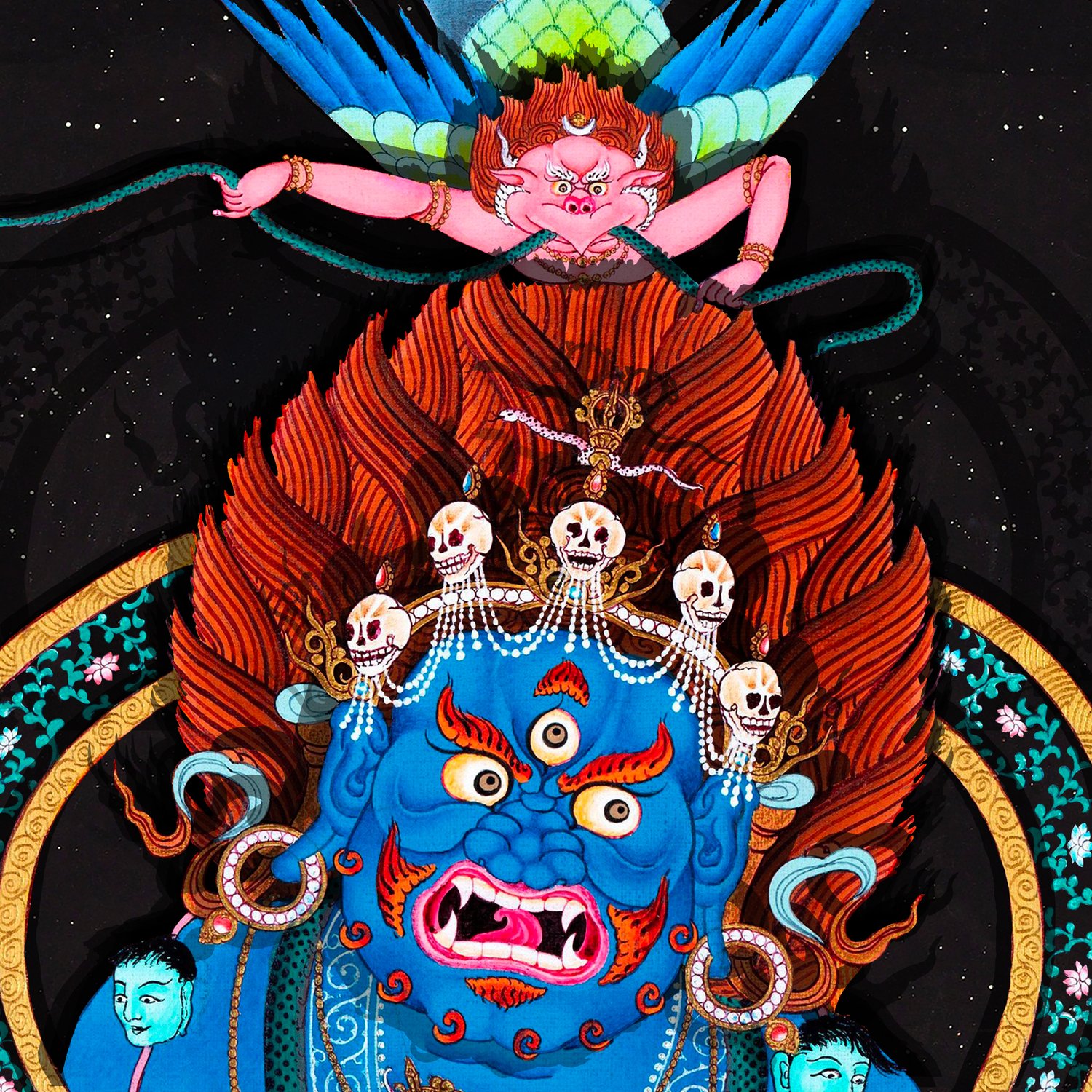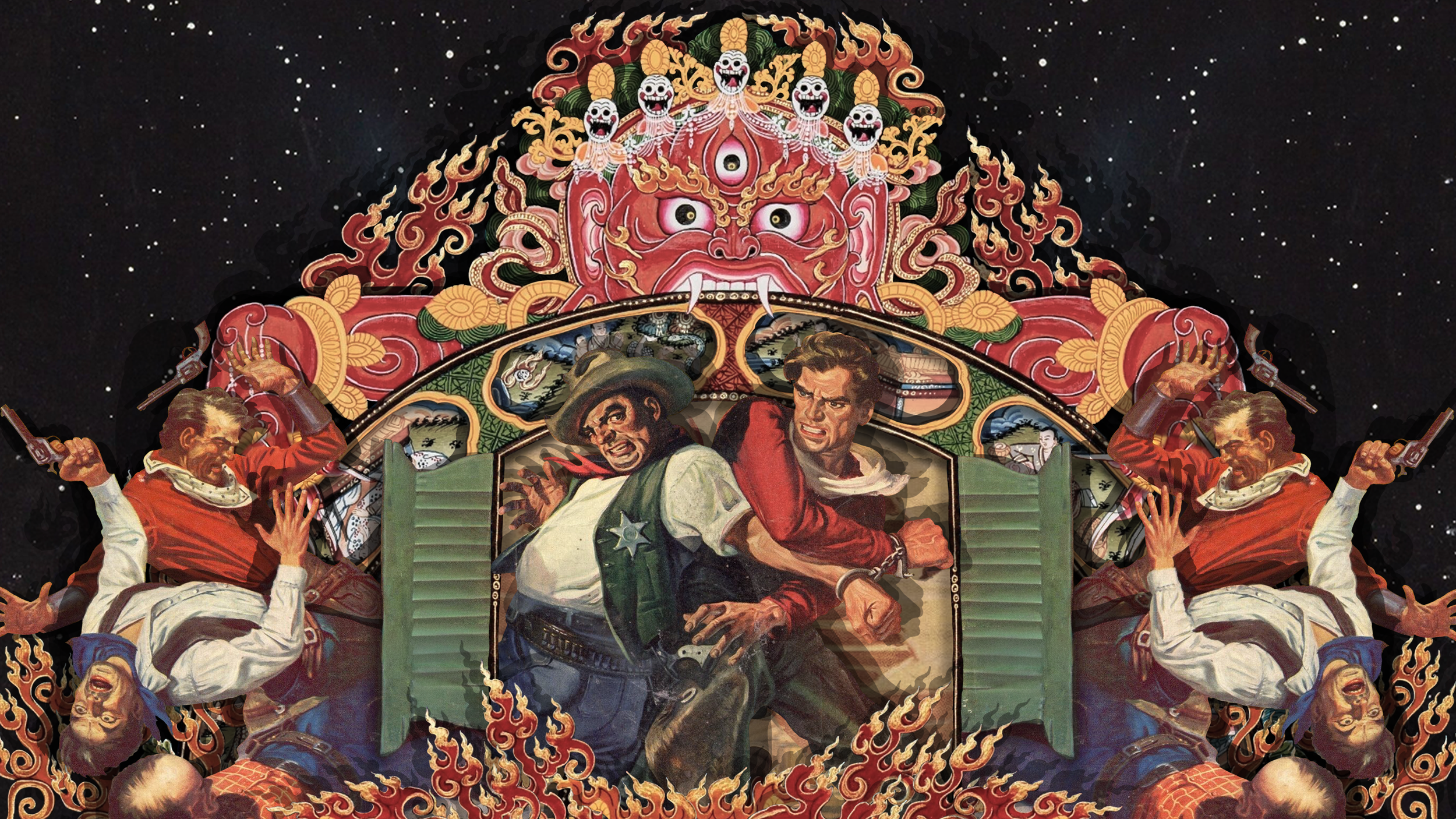The Marfa Collection
This series is a dialogue between two mythologies: the American West and the Tibetan esoteric tradition. It poses that the archetypal struggles of the frontier, including the conflicts between law and chaos, violence and peace, and the individual against the vast, unforgiving landscape, are externalizations of the internal battles described in Buddhist philosophy.
The visual language is a direct fusion of these two worlds. Using digital collage, the series appropriates the raw imagery of mid-century American pulp illustrations and integrates it into the formal, symmetrical structure of a Tibetan thangka. The familiar gunslinger or lawman is placed into a new context, their actions re-framed under the wrathful, protective gaze of a Dharmapala.
The collection follows a distinct narrative arc. It begins with the static, cosmic judgment of "Sentinel." This is followed by the tense paradox of "Peacemaker," which questions the nature of enforcement. The narrative explodes into the kinetic, karmic chaos of "Ruckus."
Ultimately, the series uses the American mythos as a vernacular to translate Buddhist concepts. It argues that the drama of the human condition is a timeless story: the struggle with our own anger, attachments, and delusions, whether it's told in a dime-store novel or an ancient sutra. The setting may be the West, but the battleground is the mind.
Collection & Release Details
This is an ongoing series with a new major work released annually to coincide with the Art Blocks Marfa Weekend. The collection is structured to engage collectors at multiple levels.
Unique Works (1/1): The core narrative pieces, including "Sentinel," "Ruckus," and "Peacemaker," are released as unique 1-of-1 works. Each is offered at auction with a starting bid of 0.1 ETH.
Bidder's Edition: All participants who place a bid on a 1/1 auction receive an exclusive, limited-edition artwork. These pieces serve as a thank you to the community, a record of participation and a game piece in future releases.
Open Edition: To make the series accessible to a wider audience, the piece titled "The Ballad" is offered as an open edition. It is priced at 0.01 ETH for the more price-conscious collector.
Provenance: All works in the Marfa Collection are minted on the Ethereum blockchain using Paper Buddha's custom smart contracts, deployed via Transient Labs to ensure authenticity and provenance.
“Ruckus" is where the American dime-store Western crashes into Tibetan mysticism. The entire piece is a mirror-image showdown, a chaotic loop built from the visual language of pulp fiction.
At the center, it’s pure action: a lawman and his adversary locked in a brawl, framed by a set of saloon doors. This isn't a singular event; the symmetrical composition turns it into a recurring nightmare, a cycle of violence that plays out endlessly. The figures flanking the main event are echoes, trapped in the same loop.
Presiding over this chaos is a wrathful Dharmapala. This isn't a demon in the Western sense; it's a protector of the dharma, a fierce guardian whose job is to destroy the obstacles and spiritual poisons that lead to suffering. Its energy is a necessary violence to combat the internal enemies of enlightenment.
Ultimately, the Western brawl is a metaphor for a war within the mind. It’s the externalization of the internal fight, the repeating, karmic cycle of anger and aggression that defines samsara. The flames at the bottom are the fires of this self made hell, but they could also be the fire that purifies. "Ruckus" uses the grit of the American frontier to map out the geography of that spiritual conflict.
"Peacemaker" is about the paradox of using force to create peace. It questions the tools of law and order and the myths we build around them. It freezes the moment right on the razor's edge between a violent resolution and a non-violent one, leaving the viewer to decide what happens next.
The title itself is a loaded term. On one hand, it’s the nickname for the Colt .45 revolver, the tool that mythically "won the West." On the other, it’s the very definition of the Buddha. The piece sits in the tension between those two meanings.
This contradiction is embodied by the central figure: a classic gunslinger who solves problems with violence, yet has a flower sticking out of the barrel of his revolver. This single image is the core of the piece. Is it an offering, a moment of doubt, or a mockery of the violence to come?
Looming behind him is the immense form of a blue Dharmapala, a wrathful deity. Its power emanates outwards, manifesting as the masked, symmetrical riders on either side. The gunslinger can be seen as an extension of this force. A worldly emanation of a cosmic protector, an enforcer of a severe kind of karmic justice.
This piece is about Law with a capital “L”, not just the brittle law of the frontier, but the inescapable law of karma. The Sentinel is a still point in a chaotic universe, a silent guardian at the gates of consequence. His presence alone is the verdict.
A sentinel is a guardian, a watcher at a threshold. The artwork is built around that idea of a fixed, immovable authority presiding over a chaotic world.
This authority is embodied in the central figure: a fusion of archetypes. Part preacher, part lawman, part judge. He holds both the book and the gun, and the sign behind him, "CHECK YOUR GUNS," is not a suggestion but a decree.
The cowboys and cowgirls flanking him are rendered static by the rigid symmetry of the composition. They are the subjects of his judgment, their pulp-fiction aggression frozen and held up for examination. The entire scene is contained within the iconography of a wrathful Dharmapala, whose mask forms the architecture of the judge's bench. The Sentinel’s authority isn't just his own; it’s backed by a cosmic, protective force.
This piece is a visual map of the human condition. It’s the violent, chaotic song of our own minds—the "Ballad of Samsara"—played out against the clear, steady note of potential enlightenment. The Dharmapala above isn't presiding over the violence; it's the fierce protector of the music, the guardian of the path.
The title "The Ballad" is the bridge between the two worlds. A ballad is a classic Western form—the ballad of the outlaw, a story of violence, tragedy, and consequence set to music. In this piece, the pulp figures are living out that tragic story.
The verses of this ballad are scenes of pure samsaric struggle: a sheriff is hogtied, law is overthrown, and the gunman's rage is mirrored, repeating endlessly. The tormented faces in the fire at the bottom are the ballad's inevitable conclusion, the karmic price for living inside that violent song.
But at the heart of the inferno sits the Buddha, completely serene, playing his instrument. He is the song's counterpoint. He's not a passive observer in the chaos; his music is the dharma itself—the teaching of the way out of the fire.





